#lm 4.12.1
Explore tagged Tumblr posts
Text
Round 1, Matchup 143: III.iv.4 vs IV.xii.1
9 notes
·
View notes
Text
History of Corinthe from its Foundation, part 1
THE Parisians who nowadays on entering on the Rue Rambuteau at the end near the Halles, notice on their right, opposite the Rue Mondétour, a basket-maker's shop having for its sign a basket in the form of Napoleon the Great with this inscription:
NAPOLEON IS MADE
WHOLLY OF WILLOW,
have no suspicion of the terrible scenes which this very spot witnessed hardly thirty years ago.

It was there that lay the Rue de la Chanvrerie, which ancient deeds spell Chanverrerie, and the celebrated public-house called Corinthe.
The reader will remember all that has been said about the barricade effected at this point, and eclipsed, by the way, by the barricade Saint-Merry. It was on this famous barricade of the Rue de la Chanvrerie, now fallen into profound obscurity, that we are about to shed a little light.
May we be permitted to recur, for the sake of clearness in the recital, to the simple means which we have already employed in the case of Waterloo. Persons who wish to picture to themselves in a tolerably exact manner the constitution of the houses which stood at that epoch near the Pointe Saint-Eustache, at the northeast angle of the Halles of Paris, where to-day lies the embouchure of the Rue Rambuteau, have only to imagine an N touching the Rue Saint-Denis with its summit and the Halles with its base, and whose two vertical bars should form the Rue de la Grande-Truanderie, and the Rue de la Chanvrerie, and whose transverse bar should be formed by the Rue de la Petite-Truanderie. The old Rue Mondétour cut the three strokes of the N at the most crooked angles. So that the labyrinthine confusion of these four streets sufficed to form, on a space three fathoms square, between the Halles and the Rue Saint-Denis on the one hand, and between the Rue du Cygne and the Rue des Prêcheurs on the other, seven islands of houses, oddly cut up, of varying sizes, placed crosswise and hap-hazard, and barely separated, like the blocks of stone in a dock, by narrow crannies.

We say narrow crannies, and we can give no more just idea of those dark, contracted, many-angled alleys, lined with eight-story buildings.

These buildings were so decrepit that, in the Rue de la Chanvrerie and the Rue de la Petite-Truanderie, the fronts were shored up with beams running from one house to another.

The street was narrow and the gutter broad, the pedestrian there walked on a pavement that was always wet, skirting little stalls resembling cellars, big posts encircled with iron hoops, excessive heaps of refuse, and gates armed with enormous, century-old gratings. The Rue Rambuteau has devastated all that.
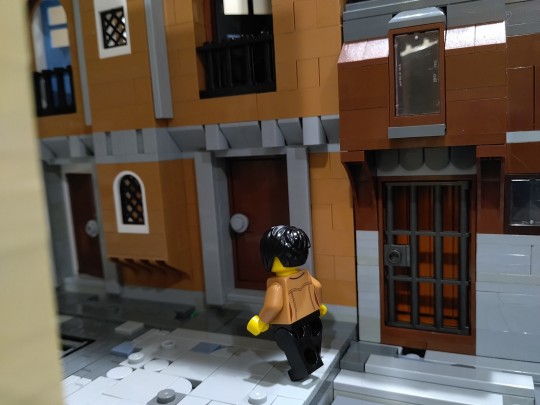
[...] The passer-by who got entangled from the Rue Saint-Denis in the Rue de la Chanvrerie beheld it gradually close in before him as though he had entered an elongated funnel.
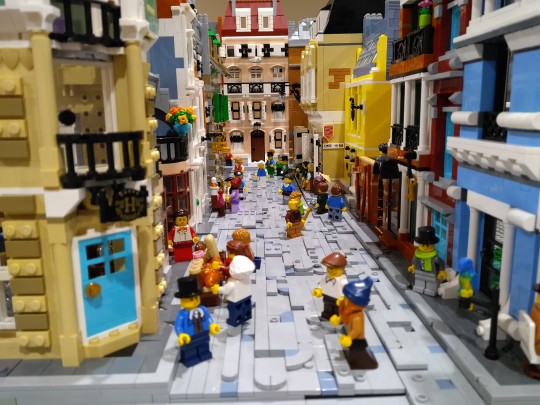
At the end of this street, which was very short, he found further passage barred in the direction of the Halles by a tall row of houses, and he would have thought himself in a blind alley, had he not perceived on the right and left two dark cuts through which he could make his escape. This was the Rue Mondétour, which on one side ran into the Rue de Prêcheurs, and on the other into the Rue du Cygne and the Petite-Truanderie. At the bottom of this sort of cul-de-sac, at the angle of the cutting on the right, there was to be seen a house which was not so tall as the rest, and which formed a sort of cape in the street. It is in this house, of two stories only, that an illustrious wine-shop had been merrily installed three hundred years before.

In the time of Mathurin Regnier, this cabaret was called the Pot-aux-Roses, and as the rebus was then in fashion, it had for its sign-board, a post (poteau) painted rose-color. In the last century, the worthy Natoire, one of the fantastic masters nowadays despised by the stiff school, having got drunk many times in this wine-shop at the very table where Regnier had drunk his fill, had painted, by way of gratitude, a bunch of Corinth grapes on the pink post. The keeper of the cabaret, in his joy, had changed his device and had caused to be placed in gilt letters beneath the bunch these words: "At the Bunch of Corinth Grapes (Au Raisin de Corinthe"). Hence the name of Corinthe. Nothing is more natural to drunken men than ellipses. The ellipsis is the zig-zag of the phrase. Corinthe gradually dethroned the Pot-aux-Roses. The last proprietor of the dynasty, Father Hucheloup, no longer acquainted even with the tradition, had the post painted blue.
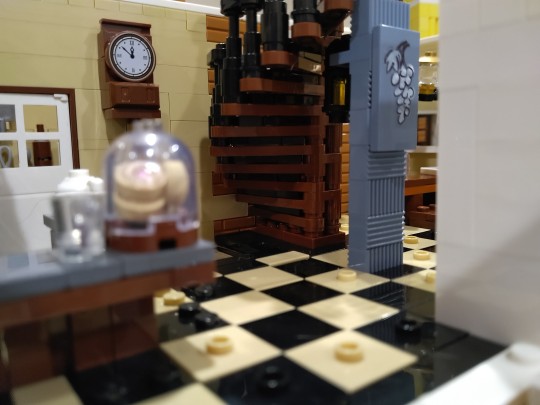
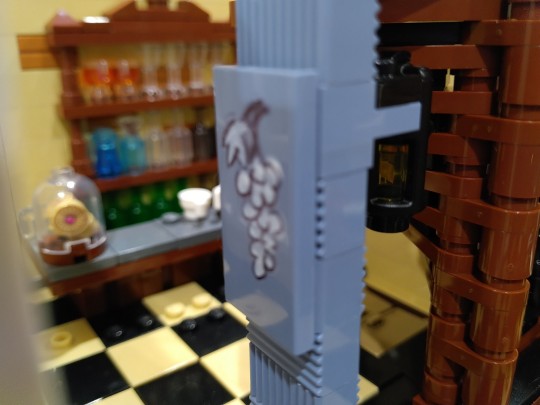
43 notes
·
View notes
Text
Can you imagine? We've been discussing what is happening in Corinthe, on the barricade, and around it for 41 days already! And the events of the morning of 5 June—add another dozen days or so. That was the longest 24 hours I have ever lived through!
30 notes
·
View notes
Text
“ It is on this famous barricade of the Rue de la Chanvrerie, which has now fallen into deep night, that we are going to throw a little light.”
A nice line! Since the barricades as seen by those there aren’t covered as widely in the historical narrative, Hugo offers to explain it. This is part of his historical style and of his political message at the same time; if “light” is Progress, “throwing a little light” on the barricade brings it into the discourse of how to achieve Progress in Hugo’s present.
“For the clearness of our narrative, we may be permitted to have recourse to the simple mode which we employed for Waterloo.”
Waterloo here may be a general reference to the somewhat historical approach taken in that digression, and it’s true that Hugo’s writing like that here, too. For example, he describes the formation of the barricades in a similar way to the layout of the battle, helping us visualize everything and locate the different actors. However, it also encourages us to consider the barricades in the context of the Waterloo digression’s themes (the people triumphing over the “great man” being an inevitable part of the 19th century; a tragic loss full of small glories for the French).
The Rue Rambuteau was part of the widening of Paris’ streets, in this case done by the Count de Rambuteau but most famously under Haussmann. Rambuteau’s project was partly in response to the cholera outbreak we’ve been reading about, and was meant to improve public health. Hugo, though, was a big fan of old Paris, hence his passive-aggressive remarks about all of these changes. They’re also meant to point out differences to his Parisian contemporaries. I think Hugo would’ve been in France for this change? But it’s very likely that many of his contemporary readers may have been curious about the layout he describes and would not have been able to find it if he didn’t mention the reorganization of the city.
It’s fascinating that M Hucheloup didn’t know French? It seems like his name is French(?), so I wonder if it’s an issue of regional dialects and languages? Mme Hucheloup is noted for not speaking a very comprehensible French, so perhaps that was it? Or is Hugo mocking their lack of education?
The Latin is a joke, though. If the more familiar expression of “carpe diem” means “seize the day” with the connotation of making the most of it, then “carpe horas” likely means the same for hours. Grantaire, then, discovered this place looking to have fun and returned because the food was good. And this is a useful thing he did! This meant that Les Amis had a place to meet in addition to the Musain! It was likely easier for him since it was the act of a friend rather than the act of an ally; he can be a good friend! He just can’t act politically.
21 notes
·
View notes
Text
Psst-- new sideblog!
So for Barricade Day this year, I started working on a lego barricade, and it kind of got out of control:
There are two posts now, covering LM 4.12.1, "History of Corinthe from its Foundations." The rest of the barricade sequence, starting with "Preliminary Gaieties," will be coming for Barricade Day, assuming nothing interferes with the rest of the photoshoot. (If it does, welp, then it will be coming for next Barricade Day.)
So if that is a thing you would like to see, go subscribe!
9 notes
·
View notes
Text
Brickclub 4.12.1 ‘History of Corinth since it’s foundation’
Oh my god it’s several pages of, just, solid symbolism, and I don’t know where to start.
@fremedon was right that we’re back in the descriptions of deserted Waterloo after the battle. In the ruined tavern at Waterloo we saw the aftermath of the coming battle in a way we won’t see after this. Now we meet Corinth before its destruction.
Go read Ellen’s writeup, in fact, it’s excellent. I’m overwhelmed by the symbolism, so I’m just going to list random things I noticed.
- What the heck is up with the wicker Napoleon? Ellen pointed out the hollowness, and the way Napoleon is nothing but an advertising slogan with no power here, Great Men go away. That fits really well! But also my pun sense is tingling, and I’m worried I’m missing something big.
- I don’t have anything like the background it would take to understand the symbolism of Corinth here, but wow I bet it’s really interesting
- Everything is so portentious and haunted. Seize the hours! Oh my god, this place is terrifying.
- There seem to be meaningful phrases and scrawled quatrains on nearly every wall. It’s like an archaelogical dig, though Hugo is bringing us back to a time before everyone is dead. It’s all so haunted. Fun fact: as a small child nothing terrified me more than seeing writing on surfaces writing wasn’t supposed to be on, and this place would have killed me.
- Apparently there’s an old poem about the skeleton of a poor lover who hanged himself on this spot?? That’s a lot! Is that Marius? Is that everyone who’s going to die for the love of the people? Is it Grantaire? Mostly it just sounds really uncomfortably like the state of mind Marius is in when he comes here. - We get our second mention in just a few chapters that songbirds are wolves! Mme Hucheloup’s confusing accent renders something that’s presumably a songbird as les loups-de-gorge--wolfthroats? throatwolves? Gavroche’s song also identified wolves and thrushes. Young Cosette was both a lark and, potentially, a wolf. (The gentler dove is dog-identified, though, as we see with Eponine. But for a while we’ve been laying out who are our cats and who are our dogs and who are our wolves, as all of them come together.)
- What do you MEAN the room where Enjolras and Grantaire die has a hidden door in it, and that fact NEVER COMES UP AGAIN ????
5 notes
·
View notes
Text
Les Mis 365: 4.12.1 History of Corinthe
Okay, first off, I love the way Hugo acts like this TOTALLY MADE UP BARRICADE is as famous and known to the reader as the one at Saint Merry-- or as Waterloo.
"The reader will remember all that has been said about the barricade built on this spot, actually eclipsed by the barricade of Saint-Merry."
Totally! The reader definitely will! ...Except not, of course, because Hugo is making this up. Still, he promises to "shed some light" on this little barricade, now "lost in obscurity"-- and I need to go into some post and have Emotions about history, because it's pretty damn definite that the light shed on Hugo's FICTIONAL barricade is actually one of the main things that's saved Saint-Merry and the rest of the 1832 uprising from falling into obscurity.
but that's going to have to wait, because there are major important in-text themes arcing back around here:
"Permit us to return, for the sake of clarity, to the simple means already used for Waterloo."
SEE THIS IS WHY THE DIGRESSIONS AREN’T DIGRESSIONS
because this chapter ALSO opens with Napoleon--a near-literal strawman, a Napoleon made out of willow, Napoleon now marking the site of the heroic café the way a café marks the site of Napoleon's last battle way back in 2.1.1
And for all that people joke about Hugo dropping anvils, and for all that he definitely DID drop anvils, this is something that people keep missing despite him basically standing on a table and screaming it here: WATERLOO AND THE BARRICADE ARE MIRRORS OF THE SAME GREAT MOVEMENT, they're both sacrifices paid to bring in the dawning of a better and more human world, a world that won't need superhuman heroics and Great Men, where the bravest of every generation won't be fed directly into the dirt for one man's glory. But the barricade is that sacrifice made willingly, with that end goal in mind, and is by that made more noble and braver and better worth remembering than the "glory" of Waterloo.
okay I think I just
I'm gonna have to break down the similarities quote by quote in another post.
Right now it's hopefully enough to pull out these bits:
Corinthe:
Persons who wish to picture to themselves in a tolerably exact manner the constitution of the houses which stood at that epoch near the Pointe Saint-Eustache, at the northeast angle of the Halles of Paris, where to-day lies the embouchure of the Rue Rambuteau, have only to imagine an N.
Waterloo:
Those persons who wish to gain a clear idea of the battle of Waterloo have only to place, mentally, on the ground, a capital A.
There are so many other echoes-- tunnels, detours, skeletons in drinking-places-- that other bits of scenery mentioned in the building have to echo even when NOT doing a close comparison. A spiral staircase, whitewashed walls, cheerful insults between teasing friends, a countrywoman's reminiscences-- all these are brighter, happier images of something seen before, in the aftermath of horror.
There are other echoes here too-- we saw a fat, winded countrywoman and a pale, delicate woman serving others together before, long ago, in a very different household. Matelote and Gibelotte may be serving people in a very different line than Magloire and Baptistine, but they, too, are serving people people--men, because this is a Hugo novel and it's the 19th century--who are undertaking a greater work and serving a high ideal in their turn.
..And like Baptistine and Magloire, their lives depend more on those men than a better, fairer society would require. Courfeyrac, Grantaire and the other Amis are pretty clearly the living support for the Corinthe since Hucheloupe died. They eat there from what Bossuet (a very different Bossuet than the first we read about, just as these are very different women) calls " piety", and given the very parental, familiar attitude of Mere and Pere Hucheloupe, it's a clear echo of FILIAL piety,in particular--but given the Amis' service to their own ideal, I think it's a bit of a nod to the other sort, too. This is, after all, a café that has served and will serve as support for those trying to enact an ideal.
But it's also just a café , and they're also just students, rough and goofy and prone to impropriety and insults--as, it seems, were Pere and Mere Houcheloupe, and I think that's important to keep in mind. This is a rough, mishmashed, not elegant or refined or perfectly-spoken sort of family, here, and this will be a rougher sort of service for the ideal,in turn. But Hugo's made it perfectly clear that what we're about to see is still as much linked with the absolute and ideal as any work in the book, and just as grand and epic as the battles of Emperors. And if it's common, a little coarse, and a bit improper, then that if anything raises it still higher.
#Les Miserables#LesMis365#LM 4.12.1#History of Corinth#Les Mis Readalong#Matelote#Gibelotte#Long post sorry#I just#have a lot of Feelings
34 notes
·
View notes
Text
IV.xii.1 Histoire De Corinthe Depuis Sa Fondation
History of Corinth From its Foundation: Wilbour, Wraxall, Jolivet, Denny
History of Corinthe From Its Foundation: Hapgood, Rose, Donougher
History of Corinth Since its Foundation: FMA
4 notes
·
View notes
Text
So, we are at the Corinthe, a fictional inn meticulously described by Hugo: including the topography of nearby streets (narrow and ideal for the barricades), its invented history, and an interior layout. The story of the inn and its last owner, a philosopher-cook Father Hucheloup is amusing, especially the part about the magical transformation of Carpes au gras into Carpe horas.
Grantaire discovered the place, and it soon became a gathering spot for “Courfeyrac and his friends” (I wonder what happened to “Enjolras and his lieutenants,” why Courfeyrac turned into a leader). It’s lovely: “There they drank, there they ate, there they shouted; they did not pay much, they paid badly, they did not pay at all, but they were always welcome.”
And Hugo would not be himself if he didn’t take a jab at working women. The way he portrays Mme Hucheloup and her waitresses is really nasty! It seems that, of all the working women in the Brick, only Fantine earns his sympathy. Why is he like this?
However, when it comes to the description of “the restaurant,” it becomes quite ominous. I realize that it’s “not a restaurant, it’s a tomb,” and a chill runs down my spine.
26 notes
·
View notes
Text
History of the Corinthe from its Foundations, Part 2
A room on the ground-floor, where the bar was situated, one on the first floor containing a billiard-table, a wooden spiral staircase piercing the ceiling, wine on the tables, smoke on the walls, candles in broad daylight, this was the style of this cabaret. A staircase with a trap-door in the lower room led to the cellar. On the second floor were the lodgings of the Hucheloup family. They were reached by a staircase which was a ladder rather than a staircase, and had for their entrance only a private door in the large room on the first floor.
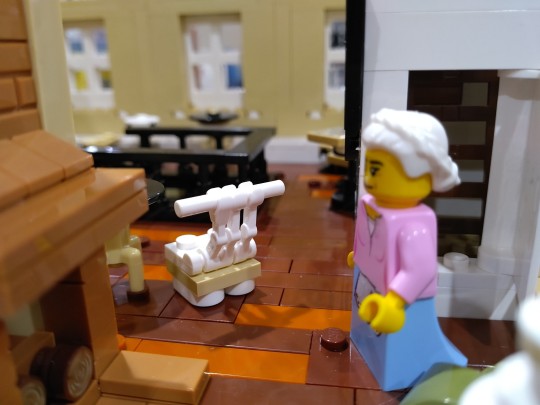
Under the roof, in two mansard attics, were the nests for the servants. The kitchen shared the ground-floor with the tap-room.
Father Hucheloup had, possibly, been born a chemist, but the fact is that he was a cook; people did not confine themselves to drinking alone in his wine-shop, they also ate there. Hucheloup had invented a capital thing which could be eaten nowhere but in his house, stuffed carps, which he called carpes au gras.

These were eaten by the light of a tallow candle or of a lamp of the time of Louis XVI., on tables to which were nailed waxed cloths in lieu of table-cloths. People came thither from a distance.

Hucheloup, one fine morning, had seen fit to notify passers-by of this "specialty"; he had dipped a brush in a pot of black paint, and as he was an orthographer on his own account, as well as a cook after his own fashion, he had improvised on his wall this remarkable inscription:
CARPES HO GRAS.
One winter, the rain-storms and the showers had taken a fancy to obliterate the S which terminated the first words, and the G which began the third; this is what remained:
CARPE HO RAS. Time and rain assisting, a humble gastronomical announcement had become a profound piece of advice.

[...] Corinthe was the meeting-place, if not the rallying-point, of Courfeyrac and his friends. It was Grantaire who had discovered Corinthe. He had entered it on account of the Carpe horas, and had returned thither on account of the Carpes au gras.
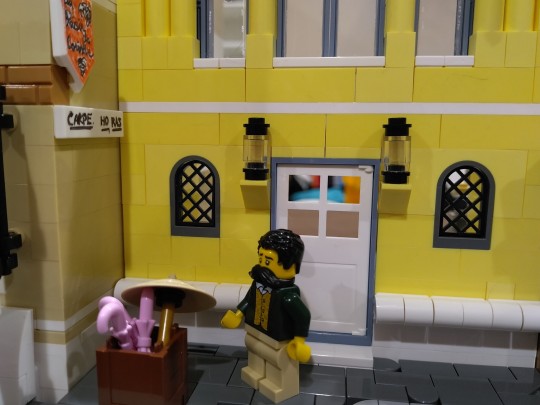
There they drank, there they ate, there they shouted; they did not pay much, they paid badly, they did not pay at all, but they were always welcome.
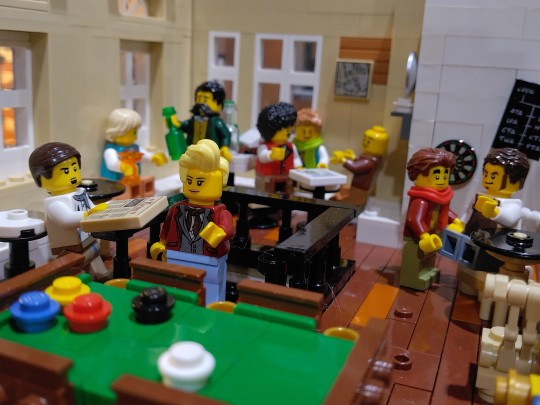
[...] About 1830, Father Hucheloup died. With him disappeared the secret of stuffed carps. His inconsolable widow continued to keep the wine-shop. But the cooking deteriorated, and became execrable; the wine, which had always been bad, became tearfully bad. Nevertheless, Courfeyrac and his friends con tinued to go to Corinthe--out of pity, as Bossuet said.
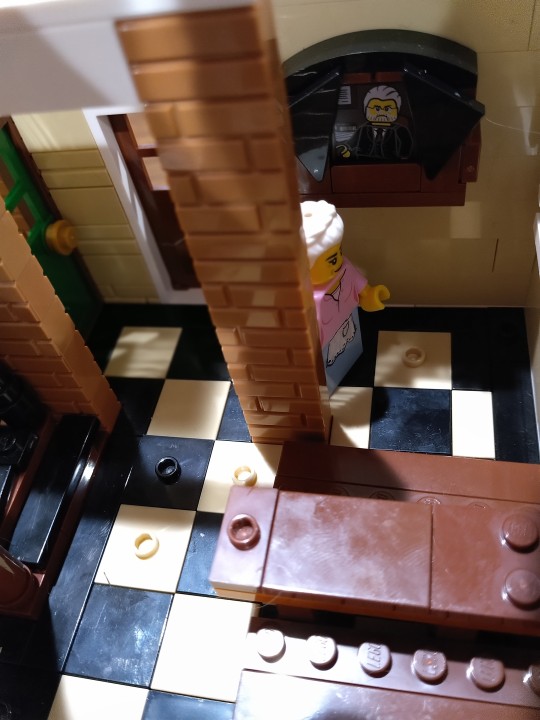
[...] The hall on the first floor, where "the restaurant" was situated, was a large and long apartment encumbered with stools, chairs, benches, and tables, and with a crippled, lame, old billiard-table. It was reached by a spiral staircase which terminated in the corner of the room at a square hole like the hatchway of a ship. This room, lighted by a single narrow window, and by a lamp that was always burning, had the air of a garret. All the four-footed furniture comported itself as though it had but three legs.
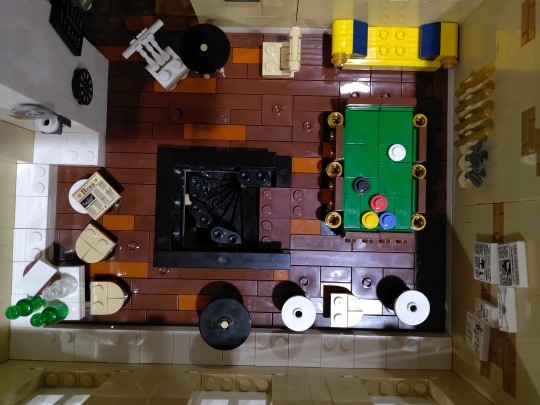
Two serving-maids, named Matelote and Gibelotte, and who had never been known by any other names, helped Mame Hucheloup to set on the tables the jugs of poor wine, and the various broths which were served to the hungry patrons in earthenware bowls. Matelote, large, plump, red-haired, and noisy, the favorite ex-sultana of the defunct Hucheloup, was homelier than any mythological monster, be it what it may; still, as it becomes the servant to always keep in the rear of the mistress, she was less homely than Mame Hucheloup. Gibelotte, tall, delicate, white with a lymphatic pallor, with circles round her eyes, and drooping lids, always languid and weary, afflicted with what may be called chronic lassitude, the first up in the house and the last in bed, waited on every one, even the other maid, silently and gently, smiling through her fatigue with a vague and sleepy smile.
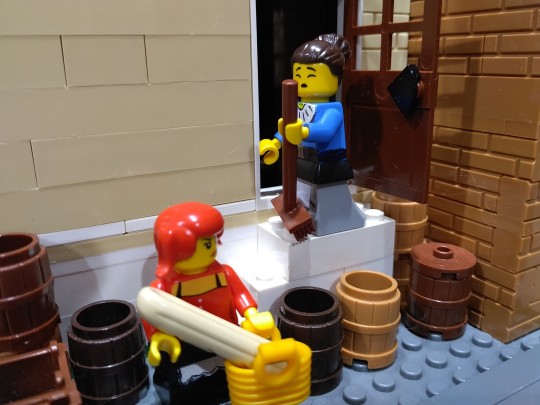
Before entering the restaurant room, the visitor read on the door the following line written there in chalk by Courfeyrac: "Régale si tu peux et mange si tu l'oses.”
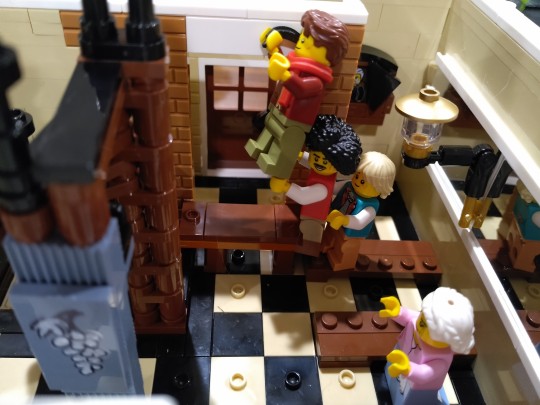
8 notes
·
View notes
Text
Brickclub 4.12.1, “The History of Corinthe from its Foundation”
So we’re back at Waterloo. And the convent, and the bagne--Hugo takes us through all of the Waterloo reflections, in fragments of the introduction to the barricade.
I’ve mentioned before that the barricade shatters the structure of the book in the way that Waterloo shatters history, so that its echoes are strewn all through the earlier chapters. (I would love to find a better metaphor than the explosion of the Jaggeroth spaceship in “City of Death,” but that’s what I’ve got.) Now we’re finally nearing the barricade itself, and all those fragments and echoes start to reappear.
Our first image--a literal signpost on the way to the barricade, a basket-maker’s sign--is a basket in the shape of Napoleon, with the inscription Napoleon est fait / Tout en osier, “Napoleon is made entirely of willow.” Once again, the story’s path is marked by images of the emperor--but here he’s hollow, reduced to an advertising slogan. Partly a dig at NIII, I’m sure, but also, the people we’re following into this place have seen the hollowness of the Empire’s promises. This place may be the mirror of Waterloo, but it’s a last stand of a group that rejects Great Men altogether. Napoleon has no power here.
This is the third place that Hugo introduces by means of an aerial map in the shape of a letter--after Waterloo’s A and the convent neighborhood’s K, we have an N laying out the streets around the Rue de la Chanvrerie.
But our introduction to the street itself reads a lot more like the description Hugo never gives us of the bagne:
...the labyrinthine criss-crossings of these four streets contrived to divide up the houses into seven oddly-shaped islets of different sizes, lying this way and that, as though at random, and barely separated from each other by narrow chinks like blocks of stone in a quarry. We say narrow chinks, and it would be impossible to give any better idea of those dark, cramped, crooked lanes lined with eight-story tenement buildings. These tenement buildings were so decrepit that in Rue de la Chanvrerie and Rue de la Petite-Truanderie the façades were shored up with beams running across from one house to another. The street was narrow and the gutter wide, anyone on foot walked on paving that was always wet, past cellar-like shops, thick, iron-ringer boundary posts, inordinate piles of rubbish, portals fitted with huge, age-old grills.
And a bit later,
Anyone coming from Rue Saint-Denis into Rue de la Chanvrerie saw it gradually narrow ahead of him, as if he had entered an elongated funnel.
The funnel shape recalls the sewer exit, which Hugo says is built like the gate of a prison.
(Fours and eights are Hugo’s numbers of doom: the tenements are eight stories; but the four streets manage to make only seven islands--this place is teetering on the edge of doom, but it’s not quite there yet.)
But for all that Hugo takes care to set the scene very specifically, he’s also explicitly describing a setting irretrievably past. As with Waterloo, where the ground has been leveled and reshaped; as with his fictional convent, set in a neighborhood that was raised to build the Gare de Lyon, these streets were gone by the time of writing: the Rue Rambuteau, the very first of the new wide, straight streets brought through the city center by urban renewal, even before Hausmann, paved over the former Rue de la Chanvrerie, and much of the surrounding neighborhood was razed.
Partly, it’s a functional choice--the geography is so changed that Hugo can change it to suit his story and no one can say he’s wrong. On the other hand, unlike with the convent, he didn’t actually change much at all--his description matches period maps pretty closely.
Those urban renewal projects, however, reshaped central Paris to make it much less suitable for barricade warfare. Hugo doesn’t know how much less suitable--we’re still a decade out from the suppression of the Commune, when Thiers will drive artillery right down those broad, straight streets and come at the barricades from behind. But the war he’s describing is one that could no longer be fought in this location.
(Despite the destruction of the surrounding neighborhood, however, the building at the corner of the Rue de la Chanvrerie and Rue Mondetour, which Hugo insists has been knocked down, is still there, now on Rue Rambuteau, not quite matching the description of the Corinthe but not too far off, either. As with No. 6 Rue de Filles-du-Calvaire, Hugo claims the places he’s describing have been erased even where they haven’t, to give himself more dramatic license.)
As for the name Corinthe--it’s come up a few times in the text. Hugo has contrasted it with Sybaris; Grantaire has dismissed it for its statue honoring the wrestler Episthates. The first and most important reference, though, is in the year 1817, just after the quote from the police prefect dismissing the Parisians as “as easy-going and indolent as cats”:
Police prefects do not believe a cat can possibly turn into a lion. Yet it can, and that is the miracle of the Paris populace. Moreover, the cat so despised by Comte Anglès was held in esteem by the republics of antiquity. It embodied freedom, in their eyes; and as though to serve as a pendant to the Wingless Minerva of Piraeus, there stood on the public square in Corinth the bronze colossus of a cat.
Cats and lions, and the transformations of cats (or puns on same, thank you Combeferre) have continued to come up--and shortly before the barricade’s fall we’ll see a literal cat at the Corinthe.
(@pilferingapples has a lot more on the Waterloo parallels, which I won’t bother to repeat; go read.)
11 notes
·
View notes
Text
History of Corinth From its Foundation: Wilbour, Wraxall, Jolivet, Denny
History of Corinthe From Its Foundation: Hapgood, Rose
History of Corinth Since its Foundation: FMA
The History of Corinthe From Its Foundation: Donougher
IV.xii.1 Histoire De Corinthe Depuis Sa Fondation
History of Corinth From its Foundation: Wilbour, Wraxall, Jolivet, Denny
History of Corinthe From Its Foundation: Hapgood, Rose, Donougher
History of Corinth Since its Foundation: FMA
4 notes
·
View notes